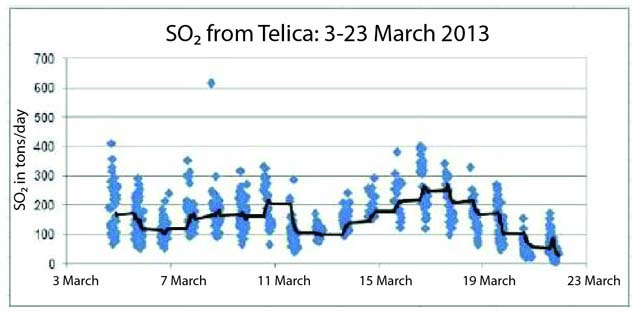Report on Telica (Nicaragua) — February 2014
Bulletin of the Global Volcanism Network, vol. 39, no. 2 (February 2014)
Managing Editor: Richard Wunderman.
Edited by Julie A. Herrick.
Telica (Nicaragua) Small explosions in September 2013; a new intracrater vent
Please cite this report as:
Global Volcanism Program, 2014. Report on Telica (Nicaragua) (Herrick, J.A., and Wunderman, R., eds.). Bulletin of the Global Volcanism Network, 39:2. Smithsonian Institution. https://doi.org/10.5479/si.GVP.BGVN201402-344040
Telica
Nicaragua
12.606°N, 86.84°W; summit elev. 1036 m
All times are local (unless otherwise noted)
INETER reported that during 2013, Telica was one of the main contributors to Nicaragua's volcanic seismicity (along with Momotombo, San Cristóbal, Cerro Negro, and Concepción). Of the total seismicity detected in Nicaragua, 28% was associated with the volcanic chain.
Throughout 2013, white, low-level gas plumes rose over 200 m above the crater. Field observers saw incandescence from the crater floor and heard jetting sounds. This activity was slightly diminished in May and peaked in late September.
In March 2013, a group of students from Chalmers University of Technology, Switzerland, surveyed the crater with an FTIR spectrometer to determine SO2 flux (figure 34). Overall, during 5-21 March, SO2 flux averaged 175 tons/day with the maximum value of 250 tons/day recorded on 17 March. The group returned to Telica in March 2014 and found fluxes of similar levels (figure 34).
 |
Figure 34. SO2 flux measured from Telica during 5-22 March 2013 by students from the Chalmers University of Technology, Switzerland. Courtesy of Vladimir Conde, Chalmers University of Technology. |
On 25 September 2013, small explosions were detected from the crater that released gas and ash. There were four explosions during 0725-1605; the largest occurred at 0725 and generated a plume 50 m above the crater rim. The other three explosions were less energetic and did not eject material beyond the crater. During a field visit that day, INETER scientists observed incandescence from a new vent within the crater as well as small fractures crossing the crater floor. An infrared thermometer measured a maximum of 505°C from the active vent.
A field survey team observed strong degassing from the crater on 8 October. The main source of the gas was the SW wall and jetting sounds were also noted.
2014. Low-level degassing continued during January-June 2014. Jetting sounds and incandescence from the crater occurred less frequently based on field visits by INETER scientists. Seismicity in January and February was elevated; 11,182 and 26,355 volcano-tectonic (VT) earthquakes were detected respectively. In April 2014, seismicity was greatly reduced (2,454 earthquakes) and was dominated by paired earthquakes known as doublets (also detected in January 2014).
During a field visit on 22 May 2014, INETER scientists noted that, while incandescence was still visible, gas emissions were greatly reduced and the jetting sounds were absent. The active vent within the crater appeared to be covered and possibly blocked by rockfalls originating from the crater walls. Emissions, jetting sounds, and incandescence were also reduced in June 2014.
Geological Summary. Telica, one of Nicaragua's most active volcanoes, has erupted frequently since the beginning of the Spanish era. This volcano group consists of several interlocking cones and vents with a general NW alignment. Sixteenth-century eruptions were reported at symmetrical Santa Clara volcano at the SW end of the group. However, its eroded and breached crater has been covered by forests throughout historical time, and these eruptions may have originated from Telica, whose upper slopes in contrast are unvegetated. The steep-sided cone of Telica is truncated by a 700-m-wide double crater; the southern crater, the source of recent eruptions, is 120 m deep. El Liston, immediately E, has several nested craters. The fumaroles and boiling mudpots of Hervideros de San Jacinto, SE of Telica, form a prominent geothermal area frequented by tourists, and geothermal exploration has occurred nearby.
Information Contacts: Virginia Tenorio, Instituto Nicaragüense de Estudios Territoriales (INETER), Apartado Postal 2110, Managua, Nicaragua (URL: http://www.ineter.gob.ni).

